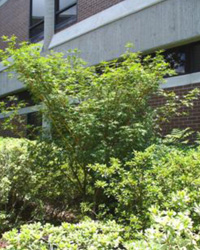Acer palmatum - Japanese maple



Family Sapindaceae (formerly Aceraceae)
Description:
Various sources place the number of maple species in the world between ninety and two hundred. Mostly, they are found in the northern hemisphere: North America, Europe, and Asia. The Japanese maple is a popular small, deciduous tree in gardens north of Florida. Dozens of varieties have been selected but only a few thrive in Florida's long, hot summers. Larger selections grow slowly to the size of a tree (up to 30 feet tall) over time. Some dwarf varieties will remain under six feet tall for decades. The sap contains less sugar than sugar maple but Japanese maples have been tapped to make maple syrup.
Location:
See a plant of the cultivar 'Glowing Embers' at the southwest corner of building 2. 'Glowing Embers' was selected in Georgia for its summer heat tolerance.
Size:
Large shrub to medium tree depending on the selection, ranging from about ten to thirty feet tall.
Care Instructions:
Light: full sun to part shade (sun for red leaf types, part shade for variegated leaves)
Water: moderate drought tolerance once established, best with some irrigation
Soil: average soil, wide pH tolerance, no special requirements
Japanese maple grows best in a moist, well-drained site. In Jacksonville, the best way to achieve this is to select a well-drained spot, dig in some organic material, mulch well after planting, and irrigate until the young tree is well-established. Then, plan to irrigate during dry spells. Shade from the afternoon sun will help. Most importantly, choose selections that have proven successful in the summer heat of southeastern United States.
